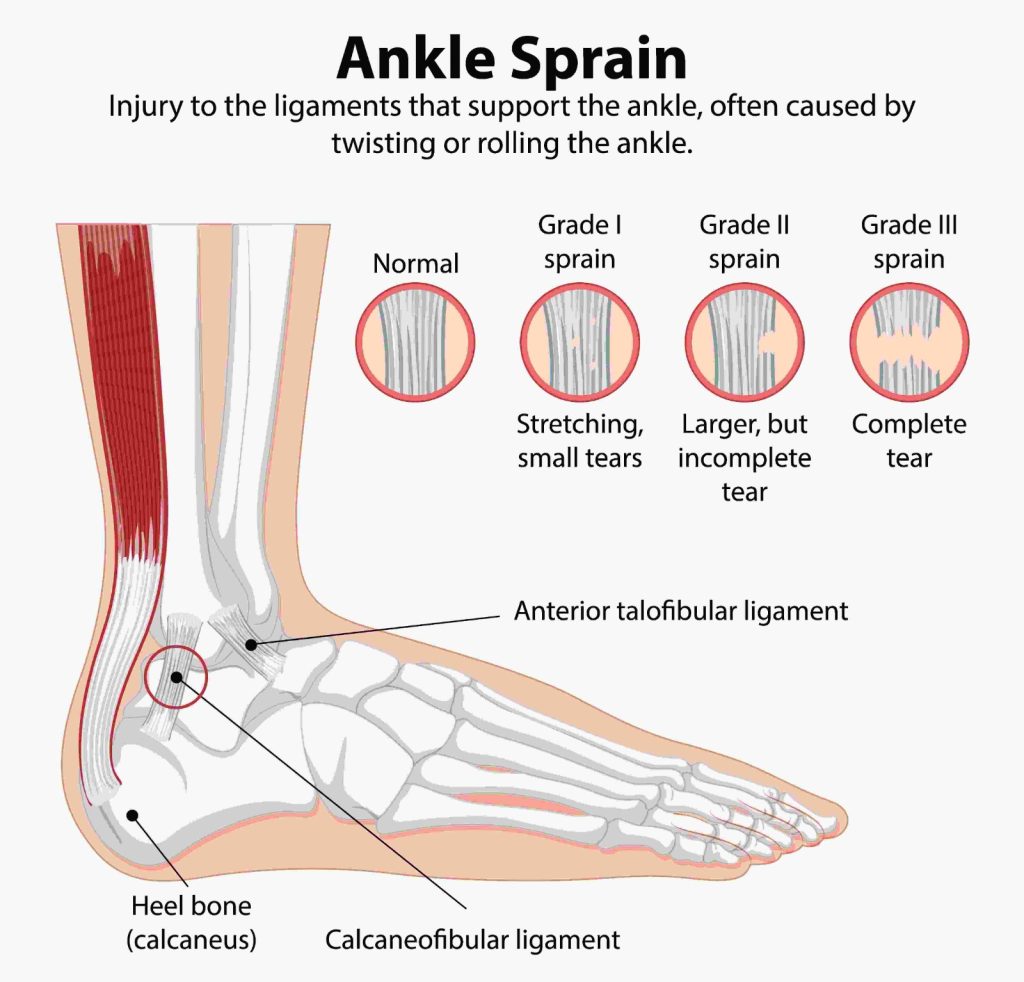Ankle instability
Ankle instability
What is ankle instability?
Upper ankle joint (OSJ) instability – wobbliness of the joint – often occurs after a serious injury. Around 15-20% of cases develop ankle instability after a serious sprain or repeated minor injuries. Instability can occur on both the outside and inside of the joint, caused by damage to the ligaments (which physiologically restrict the lateral deviation of the joint). The result of repeated sprains is often gradual wear and tear of the joint (osteoarthritis).
Typical symptoms of OSG instability
- Wobbliness and insecurity in the joint
- Frequent twisting of ankles and sprains
- Difficulty putting weight on the joint
- Pain and osteoarthritis in the long term

Causes of ankle instability
Causes of ankle instability
Chronic OSG instability is created by Repeated injuries or insufficiently healed ligament injuries in the ankle joint. It leads to a persistent feeling of insecurity and instability, which increases the risk of new sprains. In the long term, this can lead to Joint wear and tear (osteoarthritis). The treatment ranges from targeted physiotherapy to strengthen the muscles to surgical interventionsto reconstruct the ligaments and restore stability to the ankle joint.
Ankle sprains are among the most common injuries. In Austria, around 130,000 of these injuries are treated every year, while in the USA ankle sprains are registered in the millions. In this area, as in most other areas of orthopaedics, there has been significant progress in both the diagnosis and treatment of these injuries in recent years.
The anterior outer collateral ligament of the ankle joint (anterior fibular ligament) consists of two bundles – an upper and a lower bundle. In the case of minor sprains, only the upper bundle usually tears, usually at the connection to the fibula. The lower bundle remains intact and can maintain the stability of the ankle joint during an examination. However, in stressful situations, such as walking on uneven terrain, the stability is insufficient, which leads to so-called microinstability. These findings stem from scientific studies conducted in recent years.
Forms of ankle instability:
- Mechanical instability of the ankle joint
- Functional instability of the ankle joint
- Microinstability of the ankle joint

Diagnosis of ankle instability
Clinical examinations, special x-rays and occasionally magnetic resonance imaging (MRI) are used to make a diagnosis. Mechanical instabilities can often be clearly identified, whereas functional and micro-instabilities are more subtle.
Mechanical instability of the ankle joint
Mechanical instability occurs after severe injuries in which the outer collateral ligament of the ankle is torn. This leads to limited stability of the joint, which is diagnosed by clinical examinations and x-rays.
Functional instability of the ankle joint
Functional instability occurs when the patient experiences a feeling of instability but has not suffered a serious injury. Clinical examinations and imaging procedures do not show any clear damage in these cases.
Microinstability of the ankle joint
The most common form of instability is microinstability. This often develops after repeated, seemingly harmless sprains. It can often not be clearly demonstrated in the clinical examination and on x-rays.
Put an end to your ankle pain! Contact me for an appointment in my office!

Treatment for ankle instability
The treatment of ankle instability depends on the type and severity of the instability.
Conservative treatment of OSG instability
For mild instability or functional complaints, non-surgical therapy is initially recommended. This includes wearing supports or orthoses, physiotherapy exercises to strengthen the surrounding muscles and balance training on unstable surfaces.
Treatment of functional instability
Surgery is rarely necessary for functional instability. Special exercises to strengthen the muscles on unstable mats are recommended to strengthen the affected muscle groups.
Surgical treatment of OSG instability
Surgery is usually recommended for mechanical instability if conservative measures such as physiotherapy, supports or orthoses are not sufficient. In cases of chronic OSG instability , restoring ligament stability can provide long-term relief.
In cases of mechanical instability, especially after repeated injuries or severe damage to the ligaments, surgery may be necessary. The torn ligament is either repaired or, if repair is not possible, replaced with a tendon graft. These procedures are usually minimally invasive and arthroscopic.
Minimally invasive, arthroscopic techniques make it possible to repair damaged ligaments or replace them with tendon grafts if necessary. This reduces the post-operative recovery time and minimizes the risk of complications.
Treatment of mechanical instability of the ankle joint
The decision on surgical treatment is often only made when problems persist. Bandages or orthoses are often not sufficient in more severe cases, so minimally invasive surgery is considered.
Treatment of microinstability of the ankle joint
Initially, a brace can help, but patients often opt for minimally invasive arthroscopic surgery. This involves anatomically restoring the upper collateral ligament bundle. If necessary, a tendon graft is used for reconstruction.
Rehabilitation
After an operation, targeted rehabilitation is essential to restore the function of the joint. This includes physiotherapy exercises to stabilize the ankle joint and the use of supportive aids during the healing phase.
Individual advice: Do you suffer from ankle instability?
If you suffer from ankle instability or repetitive sprains, do not hesitate to contact us for a personal consultation and examination. We offer state-of-the-art diagnostics and treatment options to improve your mobility and quality of life.
Frequently asked questions about ankle instability
What are the symptoms of chronic instability in the ankle joint?
Chronic ankle instability is characterized by repeated twisting, pain and a feeling of insecurity in the joint, especially on uneven terrain.
What treatment options are there for unstable ligaments in the foot?
In addition to conservative methods such as physiotherapy and supports, minimally invasive surgery may be necessary to restore stability to the ankle joint if the ligaments are unstable.
What is the difference between mechanical and functional instability?
Mechanical instability results from structural damage to the ligaments, while functional instability is characterized by a subjective feeling of insecurity in the joint with no discernible structural damage.
Put an end to your ankle pain! Contact me for an appointment in my office!